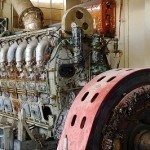No one person invented electricity, but its modern day use is the result of the work of inventors, scientists, and researchers who toiled over the subject for millennia. In order to fully understand electricity in our modern world, one has to first understand the pioneers who date back to as early as the ancient Greeks, and contemplate their work to harness the natural power of electricity and turn it into something useful to the average person. The Role of Thales of Miletus The history of electricity begins not with electricity Read More
Types of Nuclear Fuel
The different nuclear processes will use different types of fuel. In general terms: Fission reactions will use fissile heavy elements Fusion will use fusible light elements The convection point is iron. Elements heavier that iron will have higher mass than its parts and yield energy when they break apart. Lighter elements that iron will have less mass than its parts giving away energy when they fusion. Very unstable substances will not be useful, they need to be stable under normal conditions but become unstable when bombarded with neutrons. Special isotopes Read More
How Do Oil Booms Work?
Oil spills can occur with little to no notice. When a spill does happen, it becomes critical to act quickly to contain the spill in order to mitigate damage to the environment. Oil booms are commonly used in maritime environments as both a reactive action to a spill or as a preventative measure around ships that may experience an oil spill. What Makes Up an Oil Boom? Fundamentally, an oil boom is made up of a plastic tarp that has flotation embedded in the top and a thinner skirt that Read More
Automated Meter Reading
Automated Meter Reading (AMR) refers to the technology used for automating collection of water and energy (electricity or gas) consumption data for the purposes of real-time billing and consumption analysis. At any given time, the AMR system gathers real-time data and transfers the information gathered to the central database through networking technology. Benefits of Automated Meter Reading The primary benefit of this technology is more accurate and precise measurement of water, electricity or gas consumption. Consumers will be billed the amount that exactly corresponds to what they have consumed. On Read More
What is a Generator?

A generator (electrical) is a device that converts mechanical or chemical energy into electrical energy. Generators often use motors, turbines, engines, cranks, pistons, or other sources of mechanical energy. Likewise, generators may use chemicals or other materials that produce electricity when mixed or ignited. Generators do not produce electricity itself, but simply produce a flow of electricity by forcing electrons from an external source to flow through an electrical circuit. Generators are used for a wide variety of purposes and are available in many different forms. How a Generator Works Read More
Kinetic Hydropower
Kinetic hyrdopower is power created by using turbines under water to collect energy. However, unlike hydrodams that are large, bulky and often times a danger to the ecosystem, kinetic hydropower is an effective way of creating electricity without putting too much of a footprint on the area in which the turbines are installed. How Does Kinetic Hydropower Work? By harnessing the power of the moving water, underwater turbines that are grouped together are able to spin and, with the continuous momentum provided by the water, generate electricity. To make it Read More
How Wind Turbines Work
How a wind turbine works depends on the type of wind turbine discussed. While most people think of windmills as being the only true type of wind turbine, this is simply not the case, as there are horizontal axis, vertical axis, and various other types of "special" wind turbines in service around the world. Horizontal Axis Wind Turbines Horizontal axis wind turbines, also known as HAWTs are the most common and most well known types of wind turbines. They are all modeled after the classic Dutch windmills of yesteryear, but Read More
Geothermal Energy
Geothermal energy is a clean and renewable source of energy that comes from the magma typically found underneath the earth's surface. Specifically, the heat of the magma is indirectly utilized to generate large amounts of electricity using modern technology. Geothermal Power Plants Geothermal power plants have a definite advantage over other types of energy production mechanisms in terms of cleanliness and abundance. Since only naturally occurring steam and hot water are needed to generate electricity, almost no hazardous materials are produced by such facilities. As of today, there are 3 Read More


Share on: